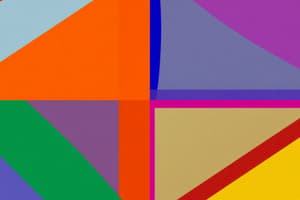Podcast
Questions and Answers
What are the properties of a parallelogram?
What are the properties of a parallelogram?
- Diagonals bisect each other (correct)
- Adjacent angles are supplementary (correct)
- Opposite sides are parallel (correct)
- All angles are right angles
What is a parallelogram?
What is a parallelogram?
A quadrilateral in which two pairs of opposite sides are parallel.
Which property is not true for all parallelograms?
Which property is not true for all parallelograms?
- Diagonals bisect each other
- Opposite angles are congruent
- Opposite sides are congruent
- Diagonals are congruent (correct)
Diagonals of a rectangle are always congruent.
Diagonals of a rectangle are always congruent.
A rectangle must be a parallelogram.
A rectangle must be a parallelogram.
Which figure does not always have congruent diagonals?
Which figure does not always have congruent diagonals?
What is a rhombus?
What is a rhombus?
A quadrilateral whose diagonals bisect each other and are perpendicular is a _____.
A quadrilateral whose diagonals bisect each other and are perpendicular is a _____.
If the diagonals of a quadrilateral do not bisect each other, what could the quadrilateral be?
If the diagonals of a quadrilateral do not bisect each other, what could the quadrilateral be?
What defines an isosceles trapezoid?
What defines an isosceles trapezoid?
What is the difference between a parallelogram and a trapezoid?
What is the difference between a parallelogram and a trapezoid?
Flashcards are hidden until you start studying
Study Notes
Properties of a Parallelogram
- Opposite sides are parallel and congruent.
- Opposite angles are congruent while adjacent angles are supplementary.
- Diagonals bisect each other and create two congruent triangles.
Parallelogram Definition
- A quadrilateral with two pairs of opposite sides that are parallel.
Properties of a Rectangle
- Shares all properties of a parallelogram.
- All four angles are right angles (90°).
- Diagonals are congruent, dividing the rectangle into four isosceles triangles.
Rectangle Definition
- A specific type of parallelogram that contains at least one right angle.
Properties of a Rhombus
- Shares all properties of a parallelogram.
- All four sides are congruent and consecutive sides are equal.
- Diagonals are perpendicular and bisect the angles from which they are drawn.
Rhombus Definition
- A parallelogram with two congruent consecutive sides.
Properties of a Square
- Shares all properties of both a rectangle and a rhombus.
- All four sides are congruent and all angles are right angles.
- Diagonals are congruent, perpendicular, and bisect the angles.
Square Definition
- A specific type of rectangle that has two congruent consecutive sides.
Parallelogram vs Rectangle
- Both have opposite sides that are parallel and congruent, but rectangles must have right angles.
Key Statement about Parallelograms
- Diagonals are guaranteed to bisect each other in all parallelograms.
Diagonals of a Rectangle
- The diagonals of a rectangle are congruent and they bisect each other.
Congruent Diagonals in Parallelograms
- A parallelogram must be classified as a rectangle if its diagonals are congruent.
Non-Congruent Diagonals
- A rhombus does not always have congruent diagonals, unlike squares and rectangles.
Quadrilaterals Definition
- A shape with four sides and four angles.
Trapezoid Definition
- A quadrilateral with exactly one pair of parallel sides.
Isosceles Trapezoid Definition
- A special form of trapezoid where the non-parallel sides are equal in length.
Properties of an Isosceles Trapezoid
- Features one pair of parallel sides, congruent non-parallel sides, congruent base angles, and congruent diagonals.
- Opposite angles are supplementary, totaling 180°.
Diagonals in Quadrilaterals
- If the diagonals of a quadrilateral do not bisect each other, the shape could be a trapezoid.
Parallelogram vs Trapezoid
- Parallelograms have two pairs of parallel sides, whereas trapezoids have only one.
Perpendicular Diagonals in Rhombus
- A parallelogram qualifies as a rhombus if its diagonals are perpendicular to each other.
Non-Congruent Diagonals in a Parallelogram
- If the diagonals of a parallelogram are perpendicular but not congruent, the shape is classified as a rhombus.
Length in Rhombus
- The relationship between the lengths of the sides of a rhombus can be calculated using the formula (a^2 + b^2 = c^2).
Studying That Suits You
Use AI to generate personalized quizzes and flashcards to suit your learning preferences.




